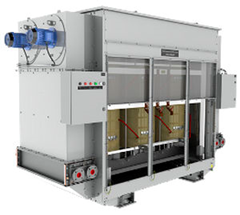Transformers
ABB claims1 that only small frequency converters (FC) can be connected to an LV network without a transformer due to harmonics and EMC requirements. The different FC types are quite diverse in the amount of produced harmonics and so are the networks in their sensitivity. The decision whether to use an individual supply transformer or not must be made case by case.
 Fig.1. Transformer.2
Fig.1. Transformer.2
The supply transformer placed between the grid and the FC covers several different tasks:
- Galvanic isolation between the frequency converter and the feeding network.
- Voltage reduction from the feeding MV or HV network to the FC input level.
- Suppression of harmonics generated by the frequency converter, thus protecting the feeding network from harmonic contamination.
- Protection of ambient and the feeding network against radio-frequency interference produced by the rapidly commutating semiconductors.
Harmonic frequencies increase the mechanical and dielectrical stresses and therefore the supply transformers must be specially designed for this duty.
Key parameters of transformers are power, voltages and transformation ratio.
There exist many kinds of transformers used with variable speed drives.
1 Source: brochure "VSD transformers" by ABB 2 Source: Trafotek